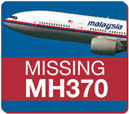Military radar trace shows MH370 turn-back, but no distress signal
A Malaysian military radar showed trace of flight MH370 turning back before it vanished early yesterday although the pilots did not issue any distress signals, the authorities said today.

The trace has prompted the authorities to widen the search area beyond the point the Boeing 777-200ER disappeared from the air over the Malaysian-Vietnamese maritime border at 1.30am on Saturday.
The authorities are looking are studying the possibility that MH370 could have made a turn-around midway through its flight to Beijing.
Air force chief General Tan Sri Rodzali Daud said that based on the recoding of military radar, there was possible indication that the aircraft did a turn-back (ATB).
"We are still trying to make sense of this because it is corroborated by civil radar,” he said today at the latest press conference held at the Kuala Lumpur International Airport. – March 9, 2014.
An ATB means the aircraft has to return to the airport of origin as a result of a malfunction or suspected malfunction of any item on the aircraft.
"When there is a situation which the pilot is unable to proceed as planned, then he will perform an ATB," said Rozali.
"However, there was no such distress signal or call made by the pilot about an ATB. We are equally puzzled by this."
Director-general of Civil Aviation Datuk Azharuddin Abdul Rahman said it had confirmation that two passengers had boarded the flight using stolen passports.
"We are now studying the closed-circuit television video footage from the check-in point to the departure lounge," Azharuddin said.
"The investigators are now studying the CCTV images and attempting to identify the actual identities of the two individuals."
Azharuddin said Malaysian counter-terrorism agencies were also investigating the two men who had boarded MH370 using stolen passports.
He refuted an earlier report that two other passengers on the flight had also used stolen passports
Asked if it is possible for a Boeing 777-200 to simply switch off all its diagnostic systems, Azaharuddin said it was something “we would all like to know the answer as well. We are speaking to airline experts and Boeing”.
Asked whether an aircraft could just disappear like that, Azharuddin said it was too early to speculate.
"You have to be fair to us, we cannot be doing things piecemeal," he said.
Meanwhile, Armed Forces chief General Tan Sri Zulkefli Md Zin said there were 22 aircraft and 40 ships currently involved in the SAR operations.
This includes assistance sent by Singapore, Thailand and the United States.
The Malaysian defence forces and the police have mobilised their respective assets to assist in the SAR operations.
Malaysia Airlines group chief executive officer Ahmad Jauhari Yahya said there were no plans to ground its fleet of 777-200.
"We are very confident in the performance of our fleet and have no plans to ground them," he said.
"The search for MH370 has been intensified and that is the main priority," he added.
Malaysia Airlines said that the plane took off at 12.41am Malaysian time and that it disappeared from air traffic control radar in Subang at 2.40am.
The timeline seemed to suggest that the plane stayed in the air for two hours – long enough to fly not only across the Gulf of Thailand but also far north across Vietnam.
But Fredrik Lindahl, the chief executive of Flightradar24, an online aircraft tracking service, had said that the last radar contact had been at 1.19am, less than 40 minutes after the flight began.
The authorities said yesterday that the last conversation between the flight crew and air traffic control in Malaysia had been about 1.30am. – March 9, 2014.

